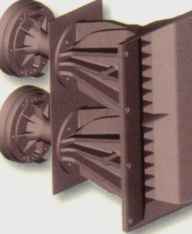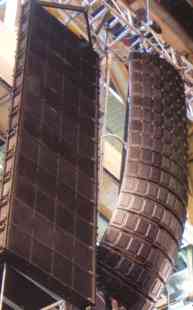A. Increasing the size of a speaker or musical instrument does not necessarily make it louder, but shifts its efficiency lower in the musical range. A large tweeter becomes a woofer. A large violin is a cello. Also a section of violins do not sound like a cello. A group of 4in speakers do not sound like a 15in speaker.
B. Theoretically, sound from a single point gives better fidelity. Grouping many speakers together to achieve power is always a compromise that reduces fidelity, regardless of the arrangement the speaker are grouped in, or marketing hype.
Large Clusters For large auditoriums, speaker cabinets are stacked in convex clusters, or vertical lines above the audience. The numbers of cabinets is varied to suit the application. This enables practical economic management. Each cabinet can be compacted with variations of -
(a) 1 15in speaker and hi-frequency horn
(b) 2 15in speakers, four 8in speakers and hi-frequency horn.

Speaker systems set up in clusters for high power cause compromises that restrict fidelity and linear dynamic power handling (sound quality changing in reference to power). Inter-modulation compounds as the power increases (inter-cluttering within the music). Wavelength distances between adjacent boxes and speaker stacks generate intense lobe and comb filter distortion, throughout the music spectrum. This reduces intelligibility and limits the overall high frequency energy.

Line source Column theory
Wavelength (Greek letter symbol Lambda)
![]() = velocity of sound / Frequency
= velocity of sound / Frequency
Velocity of sound is dependant on temperature, atmospheric pressure and humidity. It is often generalised as 344 meters per second or 1ft / milli-second. To understand how sound disperses from a system requires us to think of Frequency as its wavelength. The explanation below is basic and will be expanded in greater detail when the other chapters in this education site are completed.
Sound energy dispersing from a point source decreases by 1/4 per double the distance. Inverse square law. In theory an infinite vertical line source of sound energy can only disperse horizontally. Sound energy only decreases by 1/2 per double the distance (-3dB/2D). In reality, large line array systems approach this on a limited scale. A natural horizontal line source of sound energy is a motor way or a beach.
The majority of traditional column systems consist of a vertical row of small speakers. Often seen in churches, shopping centres, travel terminals, gymnasiums etc. Their intended application is for announcements and background music. The advantage of a column is its simplicity and being visually unobtrusive. The fidelity of a column can be no better than that of the individual speakers.

Line Source dispersion A single speaker has a varying conical dispersion. As more speakers are added vertically, sound from each speaker, is squeezed by the ones above and below. This results in increased horizontal dispersion. In reality the horizontal dispersion is wave-length limited and inconsistent. High frequencies (wavelengths less than distance between speakers) result in intense vertical lobes. These lobes cause phase cancellations and loss of intelligibility. The high frequency energy is decreased. One solution is to cross over the high frequencies to a single tweeter.

Some small expensive columns have a complex passive crossover network that reduces energy to the outside speakers as the frequency increases, so only the centre speaker remains working at the highest frequency. At lower frequencies (wavelengths longer than column length) horizontal dispersion is no longer effective. An average line-source column will have an improved but inconsistent horizontal dispersion between 2-3 octaves.
Large Line arrays
The advantages of line array systems are for very large venues (sports events) achieving far field projection with increased articulation. Modern Line array systems can be transported and rigged with astounding speed and minimal manpower resulting in lower cost and higher profit, especially for touring concerts.


The development behind the recent line array systems was driven by economic rationalism, not the discovery of new technology. However, technical improvements were needed to minimise lobe distortion between adjacent boxes. This is what most of the marketing hype is focused on.
At hi-frequencies, where our hearing is sensitive to detail the hi-frequency horn is modified so sound comes from a narrow vertical slot in the middle of the box, called a wave-guide. There are many variations in how this is achieved. A popular compact speaker box for large line array systems consists of 2 x 15in speakers, 4 x 8in speakers and a vertical slot diffraction horn in the middle of the box.

When the boxes are vertically stacked (line array) the narrow vertical wave-guide horns line up with minimal gap between them. The high frequency energy appears to come from a single very long narrow vertical horn. The upper frequencies from the horn (limited within 1KHz - 10KHz) disperse horizontally with minimal lobeing.
The original line source systems used a vertical line of rectangular ribbon tweeters in the center of each cabinet. These earlier systems with ribbon tweeters (which are still available) are of higher fidelity than the current systems. But ribbon tweeters are limited by low power handling, which is why they did not become popular.
The theoretical advantage of a line-source array is that the whole audience can hear the sound equally. Sound appears to remain at a similar level as the distance from the line-source increases. The inverse square law is reduced and horizontal directivity improved. Line-source systems are the best solution for large difficult reverberant environments (sport stadiums etc).
But the present Line source arrays are being marketed as the best solution for every imaginable application. They are not the best solution in excellent acoustical environments where fidelity is the major requirement.
Why? Line-source systems create a deviation in the character (for the use of a better word) of the sound. Line-source systems were rejected for cinemas (in the 50s) for this reason.
(A) Most sounds in nature including musical instruments and voices, originate from a point or near point source. As you move away from a point source, sound energy decreases -6dB / 2 x distance (inverse square law) and fidelity remains constant. An exception to this is a motor way or surf at a beach which act as a continuous line source of sound. As you move away from the beach sound energy decreases at approx -3dB / 2 x distance. But the way the acoustical information is experienced changes.
(B) An academic line-source has increased horizontal dispersion, sound energy decreases at -3dB / 2 x distance, at approx distance of line-source length only. A line-source will then graduate to behaving as a point source (inverse square law), over approx distance line-source height x 5, and to no greater than line-source height x 10.
(C) Line-source length must be approx x 5 to x 10 the longest wavelength (lowest frequency) for it to behave as a true line-source. Wavelengths longer than 1/10 line-source length will result in dispersion returning by increments to point source behaviour from within the distance of line-source length as the frequency decreases.
(D) At 100Hz, line-source length would have to be approx 20 meters (60ft) to behave as a true line-source. A 4 meter (12ft) line-source at 100Hz will behave as a point source, dispersing at inverse square law with improved horizontal directivity. At 1K Hz, a 4 meter line-source will behave as a true line-source, dispersing at -3dB / 2 x distance, to an approx distance of line-source height. Then as the distance increases the dispersion will graduate to point source behaviour returning to inverse square law (with improved horizontal directivity) over an approx distance of 20 meters (60ft).
(E) From the above points it can be seen that as the frequency increases the apparent acoustical centre tilts (moves) forward. This tilt improves articulation for speech and the improved directivity is beneficial in reverberant environments, especially sports stadiums and large churches. But for music in good acoustical environments the result is heard as a subjective un-natural hardening of the sound.
Limitations of line-array systems
These descriptions of vertical line-array limitations are not intended to negate the positive performance of line-array systems nor discount the technical achievement of wave-guide horns. But we must appreciate that the laws of physics govern us all and often limit our choices (regardless of marketing hype).
The fidelity of an individual line-array speaker box can not be improved by simply increasing their numbers. This is not to say that simple 3 way passive boxes stacked on top of each other do not sound acceptable in many applications but it is absurd to expect them to compare with the full dynamic musical fidelity of a large scale, fully horn loaded 4 way active system.

Line-arrays are fundamentally in-efficient and need many power amps to drive them. Automatic compression and peak limiting is often used to protect the drivers. They require extensive equalization, and very steep crossover slopes to achieve a flat response.
When sound disperses from a line-source compounding complications are introduced (diffusion and diffraction). Each of these complications can be described separately but in reality diffusion and diffraction are not separate.
Imagine a line source as an infinite number of point sources along one axis. Because sound from all points, is in the same phase along a single line of axis the sound diffuses horizontally. Diffusion in one axis causes a fidelity deviation, differently, compared to sound from single point sound source. The result is often a colored sound that is articulate but un-characteristic of how natural music sounds.
A simple visual analogy is how the world looks on a bright sunny day (light from a point source) compared to an overcast day (light diffused from a wide source). The colour spectrum is shifted and shadows diffused. Both are natural but diffusion decreases harmonic energy at approx -3dB/octave.

For a line source to work the high frequencies (where our ears are most sensitive to detail) must appear in phase as a vertical plane wave front, from the whole length of the line source. But unfortunately the horn in the middle of each box which enables this to happen comes with a curse.

What is a Diffraction Horn ? A diffraction horn is a narrow mouth horn enabling it to fit within a small narrow space. The principal is based on the narrow slit mouth being small in comparison to the sound wavelength. The intention is for sound to refract around the sides of the horn to increase dispersion.
Radial diffraction horns were available up till the mid 70s. But because of the limited frequency response, poor efficiency and how the sound music character is changed they were not popular and quickly dropped out of use. It was thought they would never be seen again. But the usefulness of diffraction horns for line-arrays caused them to make a comeback.
The following paragraphs are not defined in empirical scientific terms, but intended as food for thought.
The hi-pressure air modulation at the mouth of the horn changes rapidly to low-pressure modulation around the sides of the horn. This change is technically described as "a rapid gradient, non-linear, acoustical impedance transfer" called diffraction. Diffraction generates phase rotation of wave-lengths at the mouth edge. This phase rotation causes dispersion (directivity Q) to increase in the horizontal. Phase rotation is not acoustically audible at any one frequency and not seen on a frequency response graph. Phase rotation only effects how the modulation of different frequencies of music interact. Harmonic side-band deviation. The subjective experience is an un-natural hardening of the music.


Line-array Wave Guides Line array marketing does not refer to these horns as diffraction horns but as 'wave guides'. Wave guide horns for line-arrays must be straight, not radial. The sound must appear precisely in phase along the full length of the mouth of the horn. For this to be achieved the physical distance from the throat to every point on the mouth must be identical. There are many variations in how this is achieved. Above is a picture of an EV horn showing one way to achieve the objective. A lens labyrinth is put inside each horn. The labarenth is designed so that each path-length from the throat to any part of the mouth is identical. The engineering of wave guide horns is the only technical advancement of line-array systems that is original and deserves acknowledgement.
"Last year I saw a Bowie and U2 concert. It should have been great but it sounded like shit. I do not blame the engineer, I do blame the system. and the hype around it. I have been in this business since 1978 and seen a lot of things coming and going; anybody my age remembers the entrance and downfall of Bose, the big cole-kit Martin, Clairebros, Entec and many others. The whole business now is focused on the so-called line-array, and I agree, the dispersion is phenomenal, but the power, the pressure,.what happened to it? It does not seem to have any bass-response coming with it. As far as I am concerned, any movie-theatre nowadays sounds better, cfrt# lord of the rings, starwars, matrix. Isn't it a shame, it used to be otherwise. I think that an audience wants to feel sound pressure in the stomach , and not only in the ears, to feel something, earth shaking sound, then it becomes an event; if not, it is simpler and cheaper to play the dvd a bit louder at home".
"Hi I also think that you're right about the quality of the concerts and also that Line-arrays are completely overhyped. But you should and can get better results with conventional systems in big arena's and such. The problem is that sound engineers are totally brainwashed by big manufacturers about line arrays, that line-arrays are magic, but they're not. Sound engineers should be not so "look here I am!" kind of persons and just use their brains and especially ears".
W i d e A r r a y S y s t e m s


These wide arrays are set up as 2 way active systems. Large numbers of ribbon tweeters are arranged in a wide convex array as seen in the top pic. The ribbon tweeters create an almost pure plane wave front with virtually zero lobing. The 12in speakers are set up in rectangular dipole banks (open back) as seen in the pic on the right. The system creates a cardioid dispersion pattern, equal sound energy appears from back and front. Each speaker has a relatively flat frequency response at low power. But at high power the low frequency energy is limited, whereas the hi frequency energy appears to be unlimited. The limitation of these systems is their in-efficiency, cardiod dispersion and limited low frequency propergation. To achieve an even dynamic power response at all frequencies, these systems have to be set up in large scale arrangements.
The irony of these wide-array ribbon systems is that they have almost the opposite behaviour to many conventional line-array system. They achieve the performance described in the marketing hype of conventional line-array systems 'excellent detailed fidelity' which is what many conventional line-array systems don't achieve. However wide-array ribbon systems have been mostly experimental and it is unlikely they will be seen in mainstream application.
The marketing claims of professional speaker systems are often exaggerated well beyond the theoretical limit. The trend is for each brand to claim to have invented changes (magical transformations) from which the others follow. The result is similar to a parody in the Monty Python movie 'The Life of Brian', all believing they are individuals, except for the one who admits he's not.
Marketing often use terms referring to the benefits and not the negatives of a compromise, disregarding reference to music or physics. Eg. Constant directivity, Long throw, Short throw etc. The use of these terms can be random and may or may not be applied specifically to horn directivity. Imagine a short or long throw saxophone, a constant directivity trumpet or a time-aligned violin. 'Short throw' may refer to a cheap truncated horn that must be used at low level so not to destroy the driver diaphragm. 'Constant directivity' may refer to the internal shape of a horn being changed, in an attempt to make it effective past 3 octaves or keeping the horizontal dispersion constant over frequency. Vertical line speaker systems using rectangular ribbon tweeters have been around for many years. But regardless of marketing hype, if products are incorrectly designed or modified, the result is often a coloured or distorted mess.


